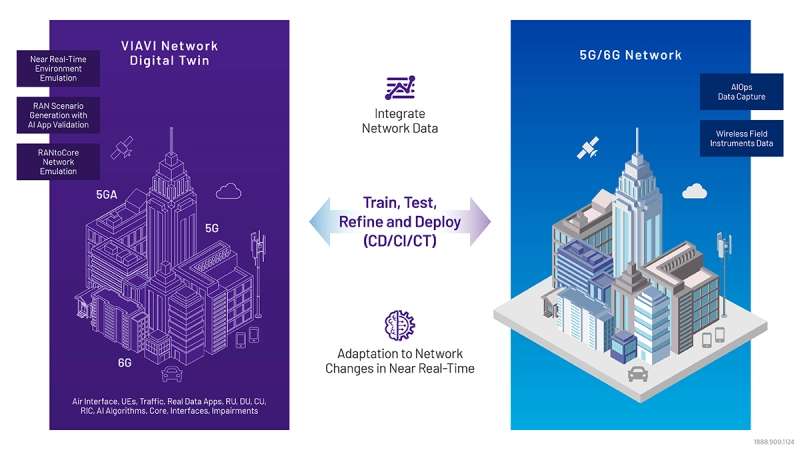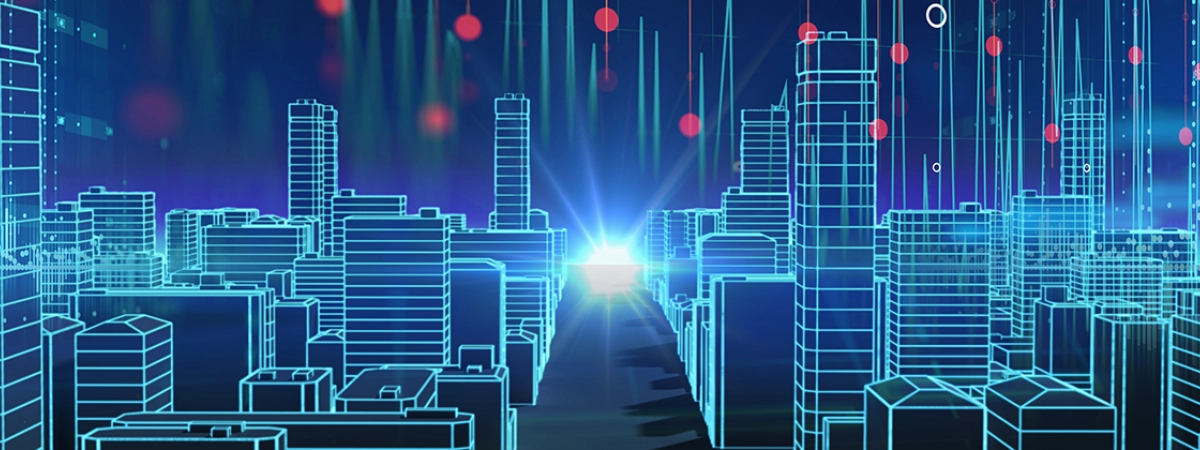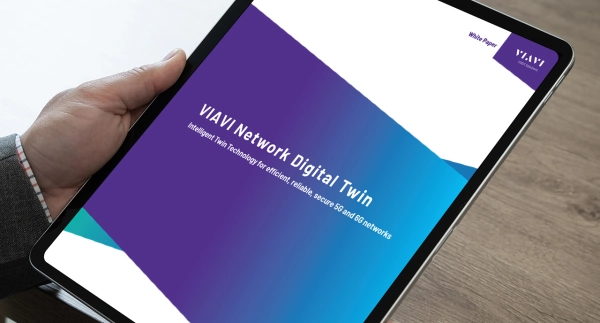Network Digital Twin
For 5G and 6G
The VIAVI Network Digital Twin enables you to create tailored digital replicas of your network. By leveraging AI and real-world field data from our instruments and software for high realism, you can simulate the RAN environment, devices, and scenarios, facilitating effective training, testing, and refinement of your network—RANtoCore—without disrupting live operations.
Choose from individual components to complete digital twin solutions that are fully adaptable to your requirements and cover the entire protocol stack.
VIAVI Network Digital Twin Solution
VIAVI’s ray tracing technology models detailed micro scenarios, like beam bouncing within buildings. The RANtoCore Network and Cloud Edge emulation solution emulates thousands of mobile devices.
RAN Scenario Generation (RSG) with AI App validation acts as a system-wide RAN Digital Twin, optimizing the entire network.
Ray Tracing excels at fine-tuning individual or small clusters of nodes, while AI RSG is ideal for a broader view. With operator data, RSG and Ray Tracing together deliver the most realistic and powerful RAN Digital Twin available.
Tailor variants to suit different network types or segments, including UE digital twin, RAN digital twin, NTN digital twins, and more.

VIAVI TM500: Emulates thousands of mobile devices on 4G/4.5G and 5G/Open RAN.
TeraVM AI RSG: simulates system-level RAN behavior, creating a RAN Digital Twin that mirrors real network conditions. Key features include:
- Accurate Simulation: Emulates various topologies, configurations, mobility patterns, and traffic profiles on real and synthetic maps.
- Multi-Network Support: Supports 4G, 5G, emerging 6G, and Non-Terrestrial Networks (NTN).
- AI-Driven Optimization: Enhances technologies like massive MIMO for advanced network performance.
VIAVI Ray Tracing: AI-empowered near real-time ray tracing Channel Generator and Network 3D Planning Tool with real-world maps and high-fidelity radio propagation channel, perfect for scenarios like mMIMO optimization and indoor modeling.
VIAVI Automation Management and Orchestration System (VAMOS): automates test campaigns, cases, and executions in a single cloud-based platform.
Beyond our wireless products, VIAVI offers a cloud-native AI for Network Operations (AIOps) platform that collects and aggregates extensive data, applying intelligent AI to separate signals from noise, rapidly identify root causes, and automatically resolve issues. This live network traffic capture solution complements the network digital twin, making it the most realistic solution on the market.
Develop and test cognitive, AI-driven Self-Organizing Networks (SON) and RAN applications in real-world scenarios.
Partner with VIAVI
- End-to-End Network Emulation: From RANtoCore, leveraging lab-to-field and field-to-lab insights to drive proven results for NEMs and CSPs throughout the R&D lifecycle.
- Best Emulator Portfolio: REST API for scheduling, deployment, configuration, execution, and result collection— with the best UE emulation solution in the market.
- Rapid Synchronization: swift alignment between physical and digital twin networks.
- AI-Driven RAN Scenario Generation: Premium datasets to fuel AI training.
- Comprehensive Protocol Capabilities: Support for the full stack of protocols.
- Real-Time Ray Tracing: Optimize EM/RF propagation
- Full Automation and Orchestration: With VIAVI Automation Management and Orchestration System (VAMOS).
- Smart Training Models: Embedded intelligent training frameworks.
- Environment Agnostic Deployment: Flexibility across various deployment environments.
- AI-Enhanced Efficiency: Better computing efficiency through AI integration.
- Extensive 3GPP and O-RAN Support: Rich support for critical features.
- Smooth Transition to 6G: VIAVI Marconi Labs’ expertise in Ray Tracing and 6G digital twin, digital twin technology, network digital twin, and digital twin network leadership for a seamless shift from 5G to 6G
Digital Twin Technology Defined
Digital twins are virtual representations of physical objects or systems that use real-time data and advanced modeling technology to accurately simulate the behavior of their real-world counterparts. The high levels of accuracy, detail, and synchronization found in digital twins allow the impact of various changes and scenarios to be tested in the digital realm. Industries and professions that have embraced the benefits of digital twin technology include:
- Aircraft designers testing the feasibility and safety of new concepts virtually.
- Manufacturing operations using digital twins to optimize process efficiency and predict bottlenecks.
- Healthcare providers and researchers predict disease progression using precise digital models of patient organs and anatomy.
- Smart cities utilize digital counterparts to optimize energy consumption and traffic flows.
A digital twin network is a virtual replica of the hardware and software comprising a physical network, including RAN, core, and user mobile device elements. Data streams from the operating network are continuously incorporated to mirror the latest network conditions. An infinite number of configurations, mobility patterns, and traffic profiles can be emulated in the twin to provide unprecedented prototyping, testing, and self-optimizing capabilities.
The Benefits of Digital Twin Networks
In all their diverse applications, digital twins provide a platform to assess new concepts in a safe and cost-effective manner. Data collected from physical networks also turns digital twins into the ultimate monitoring tools, making the impact of any changes instantly accessible. Additional benefits of digital twin networks include:
- On demand testing: New use cases and scenarios can be introduced to the network digital twin to test their impact without risking service degradation or interrupting ongoing operations.
- Resource management: Spectrum utilization and energy consumption must be continuously optimized to fulfill the promise of 5G as a sustainable topology. Modeling and analyzing network usage and traffic loads in the digital twin supports intelligent resource allocation.
- Security threat emulation: Complex multi-vector cyberattacks launched in the digital twin network help to identify vulnerabilities and mitigate risks proactively without exposing the live network to either real or synthetic threats.
- Massive MIMO optimization: Digital twins can simulate antenna misalignments and RF distortions to optimize MIMO calibration and ongoing performance. Feedback from live MIMO arrays is used by the digital twin to continually adapt antenna phase shifts and sleep cycles.
The Greatest Challenges in Building Digital Twin Networks
Digital twins emulating the behavior of objects like airplanes, buildings, or engines must continually transfer information between the physical and digital realms to maintain an accurate representation. This challenge is multiplied many times over for highly complex and unpredictable 5G and 6G networks, making them highly ambitious use cases for digital twin technology. The obvious performance, efficiency, and security benefits are gated by challenges that include:
- Data integrity: The high volume of data collected from cell towers, user devices, and other network elements can make it difficult to provide the digital twin with a consistently clean and comprehensive stream of data.
- Network slice complexity: Emulating network slices with varying performance requirements, configurations, and deployment topologies is a challenge that reflects the increased complexity of 5G vs 4G RAN.
- AI model accuracy: Highly dynamic networks push the boundaries of the artificial intelligence (AI) used to generate representative traffic, mobility, and RF channel interference scenarios.
- Scalability: Networks continue to grow in both size and complexity, so their digital counterparts must be capable of scaling and evolving quickly to stay in sync with the latest configuration.
- Security risks: The ongoing connection between digital twins and live networks makes them compelling targets for attackers seeking to corrupt network infrastructure, identify weaknesses, or intercept data transmissions.
Network Digital Twin FAQ
Let Us Help
We’re here to help you get ahead.

